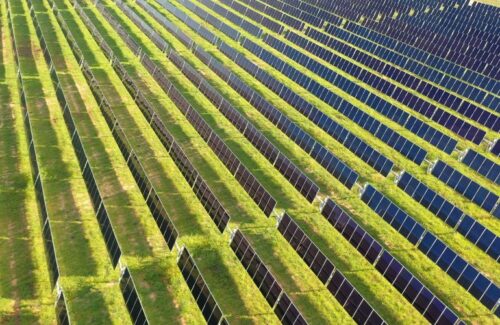Based upon a review by the SUN DAY Campaign of data newly released by the Federal Energy Regulatory Commission (FERC), renewable energy sources (i.e., biomass, geothermal, hydropower, solar, wind) provided almost two-thirds (64.64%) of new U.S. utility-scale generating capacity added in the first quarter of this year.
New utility-scale solar capacity was 2,530 MW or 39.56% of the total … and that does not include small-scale distributed PV systems. New wind capacity provided 1,475-MW or 23.06% of the total. Hydropower and biomass added 100-MW and 29-MW respectively. New natural gas capacity totaled 2,259 MW (35.32)% and was supplemented by 2 MW of new oil. No new capacity additions were reported for coal, nuclear power or geothermal energy.
In the month of March alone, all new capacity additions were provided by just solar (491 MW) and wind (409 MW). These included the 297.3-MW Seven Cowboy Wind Project in Washita County, Oklahoma and the 112-MW Deerfield Wind Energy II Project in Huron County, Michigan, as well as the 102-MW Chaparral Solar Project in Kern County, California; the 100-MW Skyhawk Solar Project in Obion County, Tennessee; and the 100-MW Crossett Solar Project in Ashley County, Arkansas.
With these latest additions, renewable energy now accounts for 27.67% of total installed utility-scale generating capacity including 11.51% from wind and 6.67% from solar.
Notably, the share of U.S. generating capacity is growing at a substantially faster rate than had been anticipated by FERC. In March 2020, renewables’ share of total generating capacity was just 22.74%. At that time, FERC projected that “high probability” additions by solar in the ensuing three-year period would be 24,083 MW. In fact, solar grew by 39,470 MW. Likewise, FERC’s three-year forecast for net “high probability” wind additions was 26,867 MW. Instead, wind expanded by 38,550 MW. Combined, new solar and wind capacity additions totaled 78,020 MW during the past three years, or 53.13% more than FERC had expected.
For the next three years, FERC is now forecasting 77,594 MW of new “high probability” solar capacity joined by 17,071 MW in net new wind capacity plus 556 MW from hydropower and 2 MW from geothermal steam. By comparison, coal capacity is foreseen as dropping by 28,507 MW, oil by 1,572 MW, natural gas by 574 MW, nuclear power by 123 MW, and biomass by 103 MW.
If FERC’s projections prove to be accurate, by the end of the first quarter of 2026, renewable energy generating capacity will be more than a third (33.46%) of the total with nearly equal shares provided by wind (12.23%) and solar (12.16%). Meanwhile the shares provided by fossil fuels and nuclear power will all decrease: natural gas from 44% to 41.83%, coal from 17.12% to 14.16%, oil from 2.99% to 2.73%, and nuclear power from 7.97% to 7.63%.
Keeping in mind, however, the degree to which FERC underestimated wind and solar growth during the past three years, U.S. generating capacity by the mix of all renewables by spring 2026 could end up being significantly higher than FERC now expects.
“Over the past three years, renewable sources, led by solar and wind, added nearly five percentage points to their share of the nation’s electrical generating,” noted the SUN DAY Campaign’s executive director Ken Bossong. “If that pace continues or accelerates — as seems likely — renewables will be providing more than a third of total installed generating capacity within the next three years and quite possibly more.”
